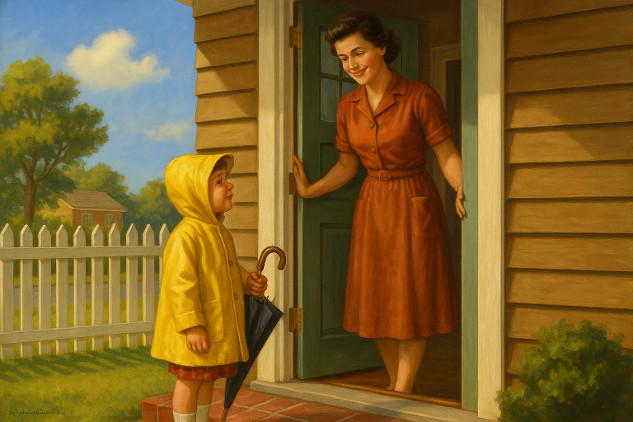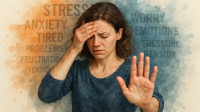
In This Article
- Why is personal resilience more important than ever?
- What is a risk watchlist—and how can it help you?
- How do you train better intuition through watching patterns?
- Which key signals should you track right now?
- How can different personalities best use this simple tool?
Seeing What Matters: A Practical Path to Everyday Resilience
by Robert Jennings, InnerSelf.comLet’s not kid ourselves: the world is hurtling towards a reckoning at an alarming pace. You can sense it in the headlines and it's a visceral feeling in your gut. Political upheaval, economic instability, climate shifts, social fragmentation—these are not distant threats, they’re here. And the only certainty left is uncertainty. Yet time and again, when the tide turns faster than expected, most people are caught flat-footed. They continue to cling to government reassurances and media pundits who didn’t foresee the last three crises and won’t foresee the next one either. If you’ve been paying attention for more than five minutes, you know this is no way to navigate a storm.
What we need is a practical habit of mind—a way to quietly watch the patterns that matter so we can move with intention when the winds shift. Enter the Risk & Consequence Watchlist. No, it won’t make you a fortune-teller. But it will empower you to pay attention where it counts. And here’s the simple truth: resilience doesn’t come from wishful thinking or blind faith in the next election cycle. It comes from paying attention—not to the noise on the surface but to the deeper signals underneath. Those who cultivate this habit tend to be the ones left standing when others are still asking, “How did we not see this coming?”
This isn’t some modern invention for technocrats or survivalist cosplay for the doomsday crowd. It’s a timeless practice for ordinary people—people who want to live well and wisely through turbulent times. And if that sounds like an old idea, it is. Our ancestors watched the weather, the animals, the markets, and their neighbors’ moods with a sharp eye. They knew that life favors the attentive. Maybe it’s time we remembered that lesson—and started watching again.
Why We React Poorly to Long-Term Threats
There’s an old saying: we’re the descendants of people who were good at running from tigers. And that’s not far from the truth. Human brains evolved in environments where the most significant threats were immediate and obvious—predators, hostile neighbors, and sudden weather shifts. If your ancestor paused to calculate the long-term risk of staying in one valley versus migrating while a bear was charging, their genes didn’t make it to us. We are hardwired to react quickly to short-term, visible dangers—and to largely ignore slow, abstract, or probabilistic threats. It’s baked into our wiring.
That’s why people will panic over an approaching storm but ignore decades of warnings about climate change. It’s why they’ll jump at headlines about one bank failure but keep assuming the financial system is stable even as underlying risks quietly build. Subtle patterns and complex risks just don’t light up the brain’s emergency circuits the way a fire alarm does. The problem is that, in the modern world, most of the truly existential threats we face—systemic breakdowns, political decay, and ecological collapse—are slow-moving, nonlinear, and complex to perceive without conscious effort.
That’s why training your perception matters. The Risk & Consequence Watchlist isn’t just a practical tool—it’s a way to gently override your brain’s ancient bias toward short-termism. By practicing the habit of watching patterns and tracking gradual shifts, you’re building a kind of “anti-tiger” wisdom: the ability to notice when the ground is eroding under your feet long before the house collapses. In the 21st century, that skill isn’t optional. It’s survival.
How the Risk Watchlist Works
Here’s the core concept: for any signal or decision you’re considering—big or small—you assign two scores. One for the likelihood that the situation will deteriorate or change soon, and one for the consequence if it does. Multiply the two, and you’ve got a priority score. No complex math is needed. The higher the score, the more attention the decision deserves. This method is equally effective for global risks and everyday choices. Should I refinance my house right now? What’s the chance mortgage rates will rise—and how much would that cost me if they do? Should I relocate? Is that storm forecast serious enough that I should carry an umbrella today? The same logic applies.
But here’s the more profound truth: the real value isn’t in the numbers—it’s in the habit of watching. By applying this lens to your daily decisions, you continuously train your pattern recognition, not just in crisis moments. Every time you assess a small choice—buying extra fuel, updating a legal document, adjusting your pantry—you’re reinforcing the habit of conscious foresight. Over time, this builds sharper intuition. And that intuition won’t just save you when the big wave hits—it’ll help you steer through everyday uncertainties more smoothly. The more you practice, the faster and more natural this thought process becomes.
Think of it like sharpening a blade. You don’t wait until a bear is charging to practice swinging an axe. You swing it daily. The Risk & Consequence Watchlist is the same—it’s a simple structure to help you think more clearly and act more wisely in small and large decisions. The people who navigate life well aren’t just those who survive collapses—they’re the ones who avoid a thousand small mistakes along the way. And that, more than any stockpile or bunker, is what resilience really looks like.
Example Signals to Watch
What should you watch? That depends on your life situation and priorities—but some signals matter to almost everyone. The key is to start noticing the patterns behind the headlines and how they ripple into your daily choices. And not every option is about surviving a collapse. Many are about making wiser everyday decisions—when to buy, when to wait when to shift small habits. Here are a few categories to help you tune your daily lens:
Financial System Stability. Are banking regulations quietly being gutted in the name of "market freedom"? Is shadow banking—those opaque, barely-regulated financial operators—rising again? Are corporate debt levels ballooning while real economic output flatlines? These aren’t just abstract numbers. They influence whether you should refinance your mortgage now or hold off. Whether to keep more cash on hand for flexibility. Whether it’s a good time to lock in a car loan—or pay some money instead. Even whether to renew a short-term insurance policy now or wait a month if markets are shifting. Thinking this way turns you from a passive consumer into an active observer of the tides shaping your financial life.
Political Integrity and Governance. Are voting rights being restricted under the banner of "security"? Are emergency powers being normalized and quietly extended? Is political violence—whether at school board meetings or statehouses—being excused or glorified? This isn’t just about "where the country is headed"—it’s about daily life choices. Do you attend that big public rally this weekend? Do you update your personal documents while government services are still stable? If the mood is darkening, do you keep more gas in your car tank than usual? Even simple things—such as renewing your passport now or deciding how much cash to keep at home—become part of wise living when governance signals shift.
U.S. Federal & Global Economic Stability. Are we watching yet another round of reckless debt ceiling brinkmanship in Congress? Are global players, such as China or the BRICS nations, openly reducing their reliance on the U.S. dollar? Is sovereign debt stress rising from Argentina to Italy? These signals shape not just pensions and investments—but also daily personal choices. Do you prepay your next property tax bill now or wait? Do you buy that appliance you’ve been putting off—in case prices jump on imported goods? Do you shift your grocery buying toward more shelf-stable basics this month? Small choices made in time compound into resilience later.
Climate and Energy Signals. Are climate policies being rolled back? Are fossil fuel subsidies growing again? Is your regional grid showing stress—rolling blackouts or extended repair times? Are food prices creeping up unusually fast at your local store? These signals shape household decisions constantly. Should you buy that extra propane tank this week? Is it time to add weather stripping to that draft door before winter? Should you move up your plan to install a small rainwater catchment barrel—so the next summer drought doesn’t catch you flat-footed? Watching climate and energy signals trains your mind to see where your household is exposed—and where small actions now can buffer you later.
Local & Community Resilience. Are certain foods disappearing from shelves? Are medical supplies harder to find? Are community services thinning—reduced clinic hours and slower emergency response times? Is neighborhood tension rising—more arguments at local meetings, more suspicion between groups? Again, this isn’t just about collapse—it’s about how you live day to day. Do you stock an extra month of key medications for your household? Do you take the time now to meet that new neighbor—you might need each other later. Is this the month to join the local garden co-op or volunteer group to weave yourself more tightly into a supportive network? Resilience is built in community first—and the signals for when to lean in are all around you if you’re watching.
The bottom line: this isn’t about waiting for some "collapse moment." It’s about cultivating daily awareness so you can adjust small choices today that add up to stronger resilience tomorrow. Whether you’re deciding when to buy a used car, how much firewood to stock when to update your will, or whether to carry an umbrella this afternoon—the habit of watching signals trains your mind to think one step ahead. The Risk Watchlist gives you a simple way to keep that habit alive.
Three Ways to Use Your Risk Watchlist
People process the world differently. One size does not fit all. Here are three ways to use your Watchlist, depending on your personality:
Structured Dashboard. If you’re analytically inclined, use the Watchlist like a personal resilience dashboard. Review it monthly or biweekly. Score each signal, track trends, and note why you adjust scores. This fosters a profound understanding of how systems evolve over time.
Quarterly Reflective Practice. For most people, a quarterly rhythm is most effective. Set aside an hour each quarter to review your Watchlist calmly. What’s moving? What needs attention? What preparations should be updated? This fosters steady, grounded awareness without obsession.
Intuitive Touchstone. For those who trust their gut, the Watchlist can serve as a visible reminder. Keep it where you’ll see it. Glance at it when big news breaks or when your instincts stir. Use it to anchor conversations with others. Over time, you’ll sense patterns more clearly—and act sooner when it matters.
Understanding Intuition and How It Strengthens Decision-Making
Let’s be clear about something: intuition isn’t magic, and it isn’t guesswork. Your brain can synthesize patterns, experiences, and hard-earned lessons—often below the level of conscious awareness. When people say, “I had a gut feeling,” what they usually mean is that their subconscious mind picked up on patterns their conscious mind hadn’t fully articulated. But here’s the catch: good intuition depends on good inputs. Garbage in, garbage out, as the saying goes. The more you expose your mind to meaningful signals over time—and the more you consciously reflect on them—the more trustworthy your intuition becomes.
This is where the Risk & Consequence Watchlist really shines. The act of watching, tracking, and periodically reflecting on key signals sharpens your pattern recognition across all levels of life. When used consistently, this practice helps you tune your internal compass. You’ll start to notice when a financial trend looks too frothy, when community tension is building under the surface, or when a series of minor local supply disruptions might mean bigger ones are coming. And this habit doesn’t just prepare you for the next hurricane or financial crash. It strengthens daily decision-making—when to repair the car instead of replacing it and when to buy an extra can of fuel. When to finally install that solar panel you’ve been meaning to get around to.
In fast-moving situations—such as emergencies, sudden economic shifts, or political unrest—intuition often outperforms formal analysis. You simply won’t have time to sit down with a spreadsheet when the grid goes down or when your local bank freezes transactions. But if you’ve been watching wisely, your intuitive sense will be ready. You’ll know when to act when to wait, and when to adapt. That’s not paranoia—it’s resilience. In a world increasingly defined by volatility, training your intuition is not some luxury for mystics or military strategists. It’s a fundamental skill for living well and wisely in uncertain times. The Watchlist gives you the training ground to build it.
Why This Practice Matters More Than Ever
In a world addicted to short-term thinking and media-driven hysteria, the Watchlist is a quiet act of rebellion. It teaches patience. It sharpens perception. It builds resilience in the same way ancient communities did—by observing the sky, the animals, the seasons, and the shifting patterns of human behavior.
The more you practice, the more precise your perception becomes. You begin to see the gap between surface events and underlying trends. You recognize when a system is approaching a tipping point—and when the smart move is to adjust your position quietly before the crowd panics.
The true gift of a Risk & Consequence Watchlist is that it builds wiser intuition—because it trains us to watch patterns over time. In a noisy, unstable world, this is no small thing. It is a path back to the kind of grounded wisdom that our ancestors knew well—and that we need now more than ever.
Start simply. Watch steadily. And trust that over time, this practice will not only sharpen your resilience but deepen your wisdom. The future may be uncertain—but how we meet it is still up to us.
About the Author
 Robert Jennings is the co-publisher of InnerSelf.com, a platform dedicated to empowering individuals and fostering a more connected, equitable world. A veteran of the U.S. Marine Corps and the U.S. Army, Robert draws on his diverse life experiences, from working in real estate and construction to building InnerSelf with his wife, Marie T. Russell, to bring a practical, grounded perspective to life’s challenges. Founded in 1996, InnerSelf.com shares insights to help people make informed, meaningful choices for themselves and the planet. More than 30 years later, InnerSelf continues to inspire clarity and empowerment.
Robert Jennings is the co-publisher of InnerSelf.com, a platform dedicated to empowering individuals and fostering a more connected, equitable world. A veteran of the U.S. Marine Corps and the U.S. Army, Robert draws on his diverse life experiences, from working in real estate and construction to building InnerSelf with his wife, Marie T. Russell, to bring a practical, grounded perspective to life’s challenges. Founded in 1996, InnerSelf.com shares insights to help people make informed, meaningful choices for themselves and the planet. More than 30 years later, InnerSelf continues to inspire clarity and empowerment.
Creative Commons 4.0
This article is licensed under a Creative Commons Attribution-Share Alike 4.0 License. Attribute the author Robert Jennings, InnerSelf.com. Link back to the article This article originally appeared on InnerSelf.com
books_
Article Recap
A personal risk watchlist is a powerful tool for building personal resilience. By training your mind to watch patterns and key signals over time, you sharpen intuitive decision making and stay prepared in a fast-changing world. Whether you use it with structure or intuition, this simple practice fosters wiser living and deeper readiness.
#RiskWatchlist #PersonalResilience #IntuitiveDecisions #ResilienceChecklist #EarlyWarningSignals #ResilienceGuide


